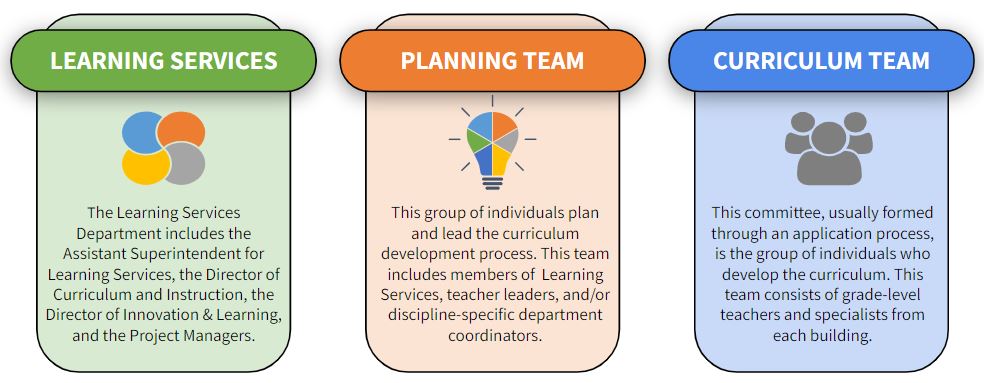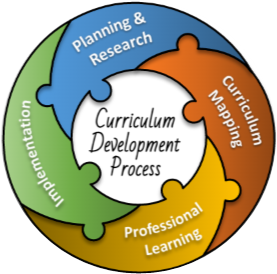Learning Services
Page Navigation
- Learning Services Overview
-
Curriculum & Instruction Overview
- E-Learning In Naperville 203
- Early Childhood
- Elementary
- Junior High
- High School
- High School Program Planning Guide
- Instructional Resources
- College, Career & Life Readiness
- Professional Learning
- Title I
- ESSER Grant
- Academically Talented
- Early Entrance to Kindergarten Process
- Accelerated Placement Process
- Parent-Teacher Conferences
- STEM Innovation
- Summer Learning
Curriculum Development Process
-
The Purpose
The curriculum development process is a critical part of any school district in order to ensure high-quality, consistent instruction for all students.
- Provides stakeholders with confidence that all students receive a common learning experience
- Establishes EC-12 vertical alignment by identifying the specific skills students need when entering and exiting each grade level in order to prevent redundancies and gaps
- Ensures continuity and consistency of instruction by providing a scope and sequence that aligns with standards and informs the PLC process
- Identifies formative and summative assessment opportunities to gauge student learning and inform instructional decisions
The Team

Phases of the Curriculum Development Process

There are four major phases of the curriculum development process: Plan and Research, Curriculum Development, Professional Learning, and Implementation. The process is ongoing and cyclical. As with any process, curriculum development is flexible and dynamic and should be tailored to meet the needs of the discipline or specific course development and to ensure that students receive a viable and rigorous curriculum.
During this phase of curriculum development, the planning team will complete the planning and research needed to begin curriculum development. Support from Learning Services will be necessary throughout this phase to ensure that the process is planned properly and effectively. In this phase, the planning team will gain a deeper understanding of the standards and of best practices in the field and education. This work will inform the next phase of the curriculum development process.
This phase is where the substance of the curriculum is written. The curriculum team will develop a written curriculum that is viable and rigorous, aligned to the standards, and articulated EC-12 so that there is a natural and logical progression of skills from one grade level/course to the next to ensure that every student is college, career, and life ready. The initial draft of the core unit maps will be created during this step. As the curriculum development process continues, this draft will be revised, especially with the selection of resources and the review of stakeholder feedback.
In order to ensure that the written curriculum becomes the taught curriculum, professional learning must be provided in a timely manner and delivered to all staff who would benefit from professional learning. Through professional learning, teachers should have a clear understanding of how to implement the written curriculum, including being able to read the unit maps, translate the unit maps into daily plans, and navigate and implement any new resources and assessments. They should also understand how and when they will be able to give feedback and whom they should seek for support if concerns arise.
Because the curriculum development process is ongoing and cyclical, an evaluation plan and timeline must be developed so that revisions can be made to improve the curriculum as needed. Stakeholders will be able to offer feedback on the curriculum throughout the implementation phase. They should have a clear understanding of when and how feedback should be provided and what impact their feedback may have on the curriculum. The information will be used to revise and improve the curriculum in order to keep it current and relevant and to prepare our students to be college, career, and life ready.

